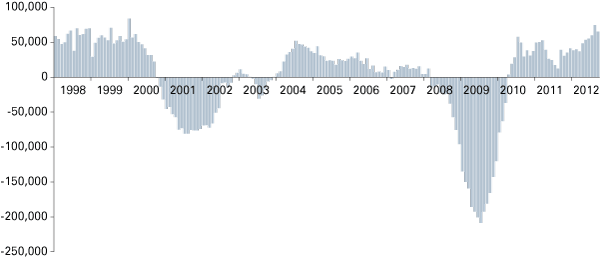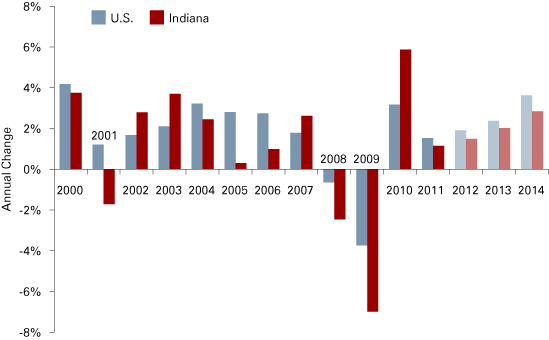Indiana’s Outlook for 2013
Director, Indiana Business Research Center, Kelley School of Business, Indiana University
A year ago I predicted that Indiana’s economy would improve only modestly in 2012, and I’m glad to report now that I underestimated the state’s rebound. Indeed, in some respects we’ve made quite notable progress. Here is an overview of Indiana’s recent performance and its economic outlook for the year ahead.
Employment and Unemployment
At the bottom of the recession, Indiana payrolls had shed nearly a quarter million jobs in just a year and a half. As Figure 1 shows, however, employment has grown steadily during the subsequent recovery. So far in 2012, payroll employment is averaging more than 50,000 jobs above last year’s levels. Moreover, the pace is accelerating, with September’s count up 65,100 from a year earlier—a rate of job creation comparable to the high-flying days of the late 1990s.
Figure 1: 12-Month Change in Indiana Nonfarm Employment, January 1998 to September 2012

Source: IBRC, using Bureau of Labor Statistics data
Job growth has been spread across nearly all sectors. Following a huge recession plunge, employment in manufacturing has grown consistently during the recovery, adding nearly 20,000 jobs over the past 12 months; to date, however, the sector has regained only about half of the jobs it lost. Jobs in private education and health services grew throughout the downturn, with sector employment now more than 30,000 above pre-recession levels.
Professional and business services jobs are up about 7,500 over a year ago, but the sector’s growth rate has slowed during the last couple of years. The only major sector to experience a decline in employment is financial activities, which has shrunk by 16,000 jobs since a year ago. Revealing a clear long-term trend, Indiana’s financial sector has contracted in all but three years since the late 1990s.
Indiana’s unemployment rate rose greatly during the recession, topping out at 10.8 percent. The rate has declined relatively steadily since then to 8.3 percent, which is still well above “normal” and represents a quarter million Hoosiers looking for work.
In 2013, we expect Indiana payroll employment to grow by more than 50,000, with gains spread across most sectors. The unemployment rate will descend very slowly, ending 2013 near 7 percent. At the current pace, we won’t be back to the pre-recession level of around 5 percent for two to three more years.
Overall Economic Output
In relative terms, as shown in Figure 2, Indiana’s gross domestic product (GDP) was hit much harder than the nation’s during the recession, but it also rose more quickly as the recovery began, led by a manufacturing rebound. The state’s economy continues expanding, but not as quickly as that of the nation. Indiana’s GDP is on track to grow 1.5 percent in 2012 and 2.0 percent in 2013—both rates are about 0.4 percentage points slower than growth nationally. On the bright side, in the coming year the state economy will finally be larger than it was before the recession.
Figure 2: Annual Change in Real GDP, 2000 to 2014

Note: Data for 2012 to 2014 are projections.
Source: IBRC, using Moody’s Analytics data
Personal Income
Following a long, gradual decline in relative terms over many years, Hoosiers’ personal income has kept pace with the nation since the recession began—accounting for about 1.8 percent of the U.S. total—and lately it’s been catching up a little. In the first half of 2012, Indiana had the nation’s 11th fastest-growing personal income. Indiana personal earnings have risen more rapidly than the national average, led by earnings from durable goods manufacturing, transportation and warehousing, and farming.
Indiana 2013 real personal income growth will start out negative in the first quarter, due to expiration of the payroll tax cut, and then rise into the upper 2 percent range the rest of the year, averaging about 1.8 percent for the full year.
Housing
Indiana’s housing market is decidedly more upbeat this year, with sales and prices up 13.1 percent and 3.6 percent, respectively, through September compared to the same period in 2011. The inventory of unsold homes on the market is down to nine months’ supply and falling, indicating that the glut of homes for sale is steadily shrinking.
We forecast Indiana existing-home sales to rise 14 percent, as employment and incomes improve, and home construction to pick up steam, with housing starts increasing by one-third over 2012 numbers.
Retail Sales
Indiana retail sales rose 8 percent in 2011, and while they’re still growing, the pace has abated somewhat. Our forecast for 2013 predicts modest retail growth of about 3 percent.
Leading Index for Indiana
The Indiana Business Research Center’s Leading Index for Indiana (LII) tends to predict changes in the state’s economic performance several months in advance. The LII in October rose 0.3 points to 100.1, its highest level since early 2008, an encouraging sign. Some components that make up the LII are moving in different directions, however, suggesting that conservative caution is in order—a time-honored Hoosier trait.
All in all, this is the best outlook we’ve offered in several years. While we don’t predict anything approaching rapid growth, 2013 promises to be a tolerable year for the Indiana economy.
Also in this Issue…
- International Outlook for 2013
- U.S. Outlook for 2013
- Financial Outlook for 2013
- Indiana's Outlook for 2013
- Indiana's Agricultural Outlook for 2013
- Three Key Indicators—Forecasts for Jobs, Income and Productivity
- Anderson Forecast 2013
- Bloomington Forecast 2013
- Columbus Forecast 2013
- Evansville Forecast 2013
- Fort Wayne Forecast 2013
- Gary Forecast 2013
- Indianapolis-Carmel Forecast 2013
- Lafayette Forecast 2013
- Louisville Forecast 2013
- Muncie Forecast 2013
- Richmond Forecast 2013
- South Bend and Elkhart Area Forecast 2013
- Terre Haute Forecast 2013




